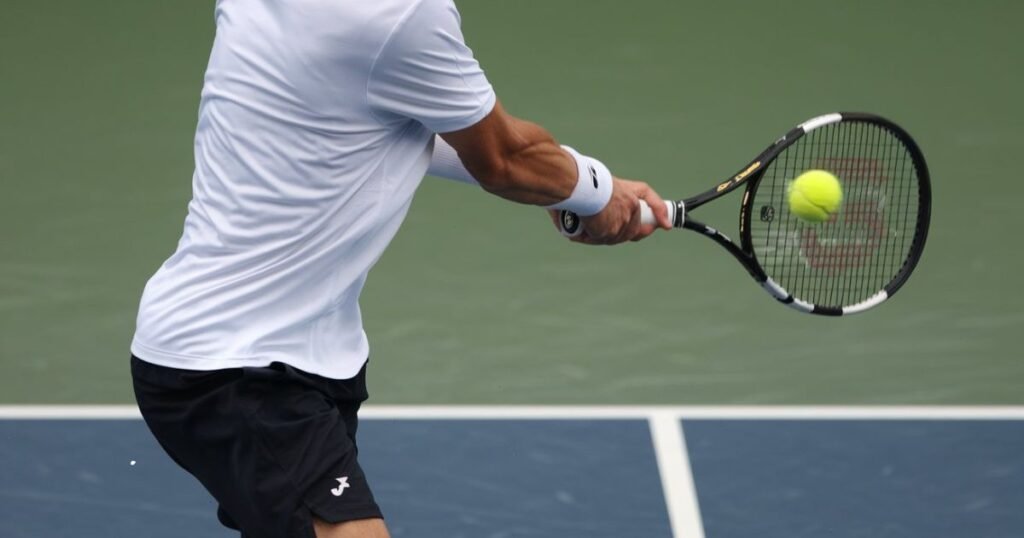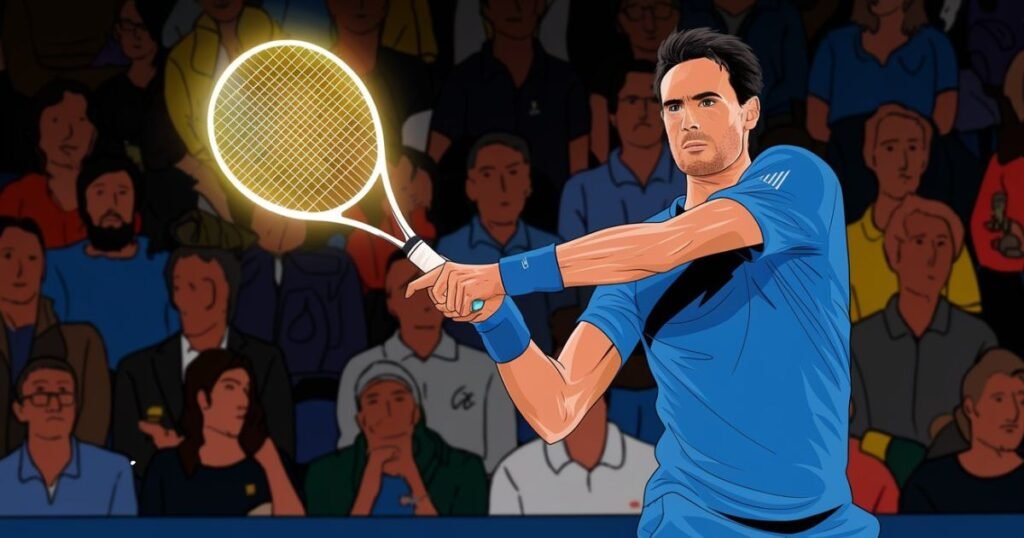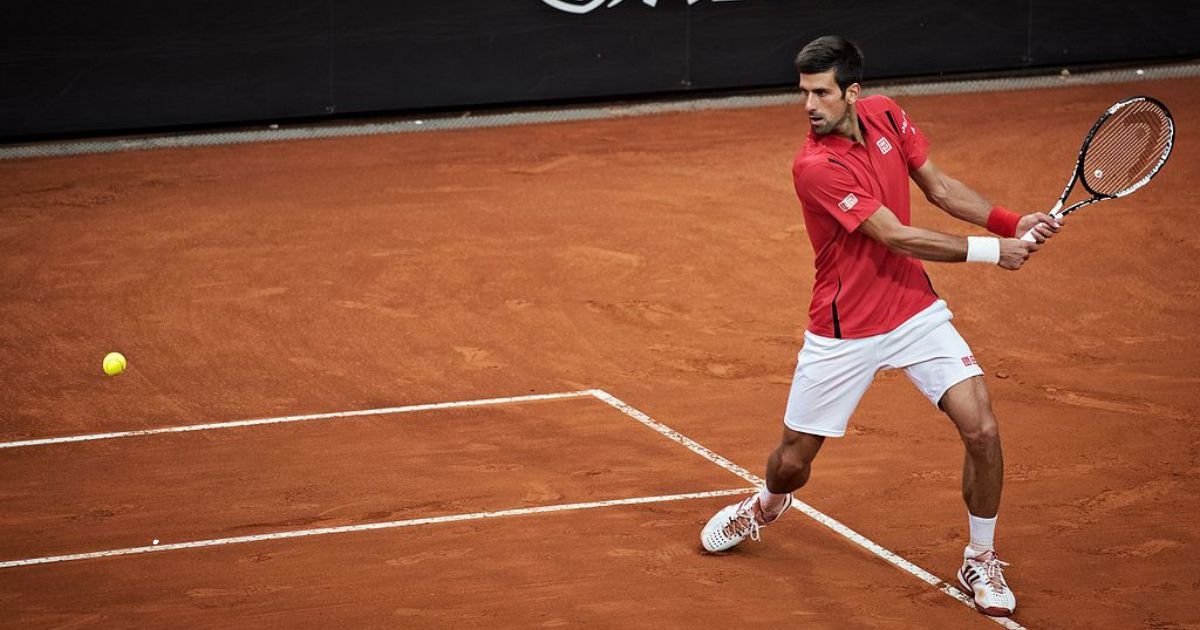Ever feel like your backhand is holding you back in tennis matches? You’re not alone. Many players struggle with this shot, but what if we told you that a single, powerful shot could change your entire tennis game? Dive into our ultimate guide to mastering tennis backhand and watch your performance soar! Whether you’re aiming for smooth one-handers like Federer or a rock-solid two-hander like Djokovic, this guide has you covered.
In this article, we’ll dive deep into everything you need to know to perfect your backhand, from fundamental techniques like grip and footwork to advanced tactics that will keep your opponent guessing. By the end, you’ll have a step-by-step blueprint to turn your backhand into a powerful weapon that can dominate rallies and win points.
Ready to elevate your game? Let’s get started!
Table of Contents
Backhand Fundamentals
The backhand is a crucial tennis shot where you swing the racquet with the back of your hand facing the ball. It’s usually used when the ball comes to your non-dominant side. Unlike the forehand, the backhand requires careful technique, coordination, and footwork, which can make it challenging to learn, especially for beginners. Despite its difficulty, a strong backhand is crucial for handling various shots and controlling the game. Mastering this stroke enhances both your defensive and offensive play, giving you more options and improving your overall performance on the court.
To perfect your tennis backhand, it’s important to first learn the foundations. Whether you’re working on a one-handed or two-handed backhand, these elements are non-negotiable.
Grip
- Two-Handed Backhand: Your dominant hand should use the Eastern forehand grip, while your non-dominant hand takes control with a Continental grip. The balance between both hands helps create power and control.
- One-Handed Backhand: The Eastern grip works best for players using a single hand, offering a blend of power and spin potential.
Stance and Footwork
- Open Stance vs. Closed Stance: Most players opt for a neutral stance, positioning their body sideways to the net. Keep your knees slightly bent, and ensure a smooth weight transfer from your back foot to your front foot during the swing.
- Split Step: As soon as you notice your opponent’s shot heading to your backhand side, perform a split step to prepare for the shot. Quick footwork is essential for executing a clean backhand.
Preparation
- Racquet Back Early: As soon as you see the ball coming, get your racquet back early. This allows you to spend more time working on your footwork and balance before making contact.
- Shoulder Turn: Rotate your shoulders fully to ensure that your body generates enough power for the backhand.
Pro Tip: Whether you’re using a one-handed or two-handed backhand, the key is early preparation. The sooner you’re set up for the shot, the more time you’ll have to adjust and hit the ball cleanly.
Mastering the Two-Handed Backhand:

The two-handed backhand offers a powerful combination of stability and strength, making it the preferred shot for many modern players.
Key Techniques
- Unit Turn: Rotate your upper body as a single unit. Your hips, shoulders, and arms should all move in unison.
- Topspin Generation: Brush up against the ball during the swing to generate topspin. Topspin adds control, ensuring that the ball dips into the court after clearing the net.
- Follow Through: After making contact, your racquet should follow through high, ideally above your non-dominant shoulder. This allows for full extension and best control.
Additional Drills
- Two-Handed Backhand Shadow Swings: Practice your unit turn and follow-through without a ball to perfect your technique. Focus on smooth, controlled movements and ensure your shoulders and hips are rotating together.
- Topspin Drills with a Partner: Have your partner feed you balls to your backhand side, focusing on brushing up against the ball to generate topspin. Aim for consistency in depth and placement.
- Balance Drills: Practice hitting backhands while maintaining a low, balanced stance. This can be done by hitting against a wall or with a partner, focusing on staying low and generating power from your legs.
The two-handed backhand needs constant practice and technique development to become an expert. By integrating these key elements and drills into your training, you’ll enhance your ability to execute this powerful stroke effectively and consistently.
Quick Tip: Stay low throughout the shot, bending your knees to generate power from your legs. This helps with balance and consistency.
Perfecting the One-Handed Backhand
The one-handed backhand may require more finesse, but when executed well, it’s one of the most elegant shots in tennis. Players like Roger Federer and Dominic Thiem have turned it into a weapon.
Key Techniques:
- Timing Is Everything: The one-handed backhand relies heavily on timing. To have the best accuracy, strike the ball at waist height.
- Swing Path: Unlike the two-handed backhand, the one-hander requires a straight arm at contact. Swing low to high for topspin.
- Follow Through: After contact, your racquet should finish high above your shoulder, with your arm fully extended.
Common Mistakes to Avoid:
- Hitting Late: If your backhand lacks power, you might be hitting the ball too late. Make touch slightly in front of your upper body.
- Weak Wrist Action: Avoid flicking your wrist; instead, rely on shoulder rotation and body weight to generate power.
- Poor Footwork and Positioning: If you struggle with weak or inaccurate backhands, poor footwork might be the issue. Adjust your footwork early, and take little steps to get into position. Ensure you’re side-on to the ball before swinging.
- Incorrect Grip: Using the wrong grip can limit your control and power. For a two-handed backhand, use an Eastern grip with your dominant hand and a Continental grip with your non-dominant hand. For a one-handed backhand, use a Continental or Eastern grip.
- Swinging with Only the Arms: Relying solely on your arms limits power and consistency. Start your swing from your lower body by engaging your legs and core; rotate your hips and shoulders for a more effective stroke.
- Inconsistent Follow-Through: Stopping your swing too early can lead to inconsistent shots. Focus on a complete follow-through, finishing high and across your body for a two-handed backhand or in front of your body for a one-handed backhand.
- Not Using Spin: A flat backhand can be easier for opponents to attack. Incorporate topspin by brushing up the ball with the racquet and use a slice backhand for defensive situations. Regularly practice different types of spin to add versatility to your game.
Advanced Backhand Strategies:

Once you know the basics, it’s time to make your backhand stronger. Using different backhand techniques keeps your opponent guessing and gives you more control over rallies.
Offensive Backhand
The offensive backhand is designed to put pressure on your opponent and dictate play. Focus on generating power and hitting deep into their court to force them into a defensive position.
- How to Execute: Use an aggressive stance by stepping into the shot, and transferring your weight from your back foot to your front foot. Ensure a strong follow-through and aim to hit with topspin to strike the ball with speed while keeping it within the court’s boundaries.
- When to Use It: Employ this shot when you want to control the rally and create opportunities to finish the point. It forces your opponent to handle difficult returns, putting them on the defensive.
Defensive Backhand
The defensive backhand helps you recover when you’re under pressure or out of position. It allows you to stay at the point and reset the rally.
- How to Execute: Use a more open stance and hit the ball higher and slower, incorporating topspin or slice. Aim for deep, loopy shots to push your opponent back and give yourself time to regain position.
- When to Use It: Use this shot when you need to stay at the point and prevent your opponent from exploiting your vulnerable position. It’s effective for buying time and regaining control of the match.
Backhand Slice
The slicing shot is flexible and may be utilized both offensively and defensively. The goal is to create backspin, causing the ball to stay low after it bounces.
- How to Execute: Open the racquet face and make a downward slicing motion. Keep the shot low and controlled, ideally skimming just over the net.
- When to Use It: The slice is especially useful when you’re under pressure or trying to change the pace of the rally. It can also be a great approach shot, forcing your opponent to hit up on the ball.
Backhand Drop Shot
The drop shot is a surprise weapon that catches your opponent off-guard by bringing them into the net unexpectedly.
- How to Execute: Hold your racquet loosely and tap the ball lightly, using the same motion as a normal backhand until the last second.
- When to Use It: Use the drop shot if your opponent is far behind the baseline. It’s most effective on slower courts like clay.
Pro Tip: Always disguise your slice and drop shots. Your opponent should only realize it’s a slice or drop shot at the last moment, giving them less time to react.
Improving Your Backhand
Consistent practice is key to mastering the backhand. The following drills can help you get better at your technique:
Wall Drills
Practice hitting against a wall to refine your backhand. Focus on keeping the ball low and maintaining a consistent pace. Aim for a target you mark on the wall to enhance precision.
Shadow Swings
Practice swinging without hitting a ball. This helps you fine-tune your swing path and footwork. Focus on smooth, fluid movements and a full follow-through.
Crosscourt Backhand Drill
Find a practice partner or hit against a wall. Aim for crosscourt backhands, focusing on consistency and depth.
Live Ball Drills
During match play, focus on setting up points where you can hit your backhand. Deliberately place yourself in situations where you’ll need to rely on this shot to build muscle memory under pressure.
Conclusion
Improving your tennis backhand is essential for improving your game and earning a competitive advantage. You can make your backhand a powerful and reliable stroke by improving your technique, developing your coordination, and perfecting your footwork. Whether you’re working on a one-handed or two-handed backhand, regular practice and effective drills will substantially improve your court performance. A well-executed tennis backhand improves your defensive and offensive techniques and increases your flexibility. Start using these strategies right away to turn your tennis backhand into an asset in your game. Explore our blog for more tips and advice on how to improve your tennis skills!
Share this blueprint with your tennis friends and start practicing together. Encourage each other and track your backhand improvement over time!
Don’t forget to share this article on your social media and spread your tennis knowledge!
FAQs
What’s the difference between a one-handed and a two-handed backhand?
A one-handed backhand uses only one hand on the racquet and offers more reach and slicing options, while a two-handed backhand uses both hands for added stability and power, making it easier to generate topspin.
How can I generate more power on my backhand?
Power comes from efficient weight transfer and shoulder rotation. Make sure to prepare early, shift your weight from the back foot to the front foot, and rotate your shoulders during the swing.
What’s the best grip for a backhand?
For a two-handed backhand, the most common grips are the Continental for the non-dominant hand and Eastern for the dominant hand. For a one-handed backhand, the Eastern grip is preferred.
How can I improve my backhand technique?
Focus on key elements like proper grip, consistent footwork, and a smooth follow-through. Practicing shadow swings and wall drills can also help.
Why is topspin important for a backhand?
Topspin helps the ball dip quickly after clearing the net, giving you more control and making it harder for your opponent to attack.
How can I add power to my backhand?
Generate power by using your legs and hips to drive the shot, and make sure to follow through fully with your racquet.
What’s the best way to practice my backhand?
Incorporate a mix of wall drills, shadow swings, and crosscourt backhand drills into your practice routine to build consistency and improve technique.
How do I handle a backhand shot when I’m out of position?
Use a defensive backhand with a higher trajectory and topspin to give yourself time to recover and reset your position.
When should I use a slice in tennis backhand?
A slice backhand is useful for changing the pace of the rally, approaching the net, or handling low balls with control.



Pingback: How to Hit a One Handed Backhand - A Complete Guide
Pingback: Jannik Sinner - The Story of a Tennis Star